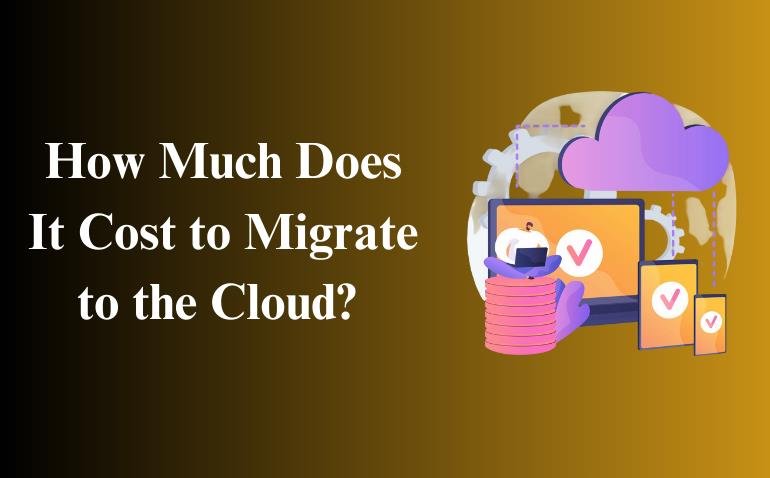Table of Contents
How Much Does It Cost to Migrate to the Cloud?
Over the past decade, businesses have increasingly embraced cloud technology to modernize IT environments, reduce operational complexity, and gain scalability. From small startups looking for agility to global enterprises pursuing large-scale digital transformation, cloud adoption has become a strategic imperative. Despite the obvious benefits, one critical question consistently arises: how much does it cost to migrate to the cloud?
The answer is not straightforward, because cloud migration costs vary significantly depending on the size of your infrastructure, the complexity of your applications, the industry you operate in, and the type of migration strategy you choose. While smaller companies may be able to migrate for as little as a few thousand dollars, large enterprises with complex workloads can easily spend millions. To make sense of these variations, it’s important to break down the cost components, understand hidden expenses, examine the pricing models of leading cloud providers, and explore strategies for optimizing costs.
What Is Cloud Migration?
At its core, cloud migration refers to moving digital assets such as applications, data, workloads, and IT resources from on-premises systems or other hosting environments into the cloud. There are several approaches to this process, and the chosen method significantly influences overall costs. A lift-and-shift migration involves moving applications as they are, with minimal or no modifications, making it one of the least expensive approaches. However, it often does not fully leverage the benefits of cloud-native services. A re-platforming strategy involves making small adjustments to applications—for instance, moving from a self-managed database to a managed cloud database service—which requires moderate investment but delivers greater efficiency. More complex migrations, such as refactoring or re-architecting, involve rebuilding applications to take advantage of microservices and cloud-native tools. This approach is far more expensive in the short term but can deliver long-term cost savings and performance improvements. Some organizations also pursue hybrid or multi-cloud migration, combining private, public, and on-premises resources, which offers flexibility but adds cost and complexity.
Major Cost Components in Cloud Migration
When organizations begin calculating the price of cloud migration, they often focus exclusively on infrastructure costs. However, the total expenditure involves far more elements. The first category to consider is assessment and planning. A readiness assessment, workload mapping, and cloud strategy consultation can cost anywhere from $5,000 to $50,000 for mid-sized companies, depending on complexity. Infrastructure itself—compute, storage, networking, and load balancing—forms the ongoing operational cost, which can be substantial.
Application migration also contributes significantly to expenses; refactoring or re-architecting applications may cost anywhere from a few hundred to several thousand dollars per application, depending on complexity. Data migration represents another major factor. While transferring data into the cloud is often free, moving data out of the cloud incurs “egress fees.” Transferring data generally costs between $0.08 and $0.12 per gigabyte, which adds up quickly for companies handling terabytes or petabytes of information.
Security and compliance must also be budgeted for, as regulated industries such as healthcare and finance require more advanced protections, audits, and certifications, which may cost anywhere from $10,000 to $200,000. Organizations also frequently overlook training and change management, yet upskilling employees on cloud technologies often runs $500 to $2,000 per employee. Finally, there is the cost of downtime or business disruption, which can be considerable. For example, if a business generates $50,000 in revenue daily, just four hours of downtime during migration can translate into more than $8,000 in lost income.
Pricing Models of Leading Cloud Providers
The pricing models of cloud providers add another layer of complexity. Amazon Web Services (AWS) offers on-demand pricing, where organizations pay per second or hour, and also provides discounted reserved instances for customers willing to commit for one to three years. Spot instances offer steep savings but are not reliable enough for production workloads. Microsoft Azure also follows a pay-as-you-go model but provides hybrid use benefits that allow companies to reuse on-premises licenses in the cloud, which can reduce costs for enterprises already invested in Microsoft products. Google Cloud Platform (GCP) has its own model, offering sustained use discounts when workloads run continuously, along with low-cost preemptible virtual machines similar to AWS spot instances. Other providers such as IBM and Oracle often target specific industries with tailored pricing, particularly in finance and healthcare.
To get an accurate estimate, organizations should use provider calculators such as the AWS Total Cost of Ownership Calculator, Azure Migrate, or Google Cloud Pricing Calculator.
Hidden and Overlooked Costs
Unfortunately, there are always hidden or overlooked costs. One of the most common is data egress fees, which apply when businesses move data out of the cloud or across regions. Performance tuning also creates unexpected expenses because organizations often need to optimize workloads after migration through load balancing, monitoring, and scaling. Another hidden cost arises from vendor lock-in. Once workloads are deeply integrated with a specific provider’s services, switching to another cloud can be complex and costly. Premium support plans also add expenses; enterprise-level support packages from AWS or Azure can run into thousands of dollars per month.
Factors That Influence Migration Costs
Several factors influence the final cost of migration. The number of workloads and the size of datasets play a major role, as does the industry in which the business operates. Highly regulated sectors must budget more for compliance. The chosen migration strategy also makes a difference, with lift-and-shift being less expensive than full refactoring. Finally, the question of whether the migration is managed internally or outsourced to a cloud migration partner affects costs as well, since external specialists charge for their services but can reduce risks and prevent costly mistakes.
How to Estimate Your Migration Costs
To calculate costs systematically, businesses can follow a framework. Start by listing all workloads and data assets, then estimate infrastructure usage in terms of CPU hours, memory, storage, and bandwidth. Next, add one-time costs such as consulting and re-architecture. Hidden expenses such as egress fees and downtime should also be factored in. Finally, apply pricing models using provider calculators.
For example, a mid-sized company migrating 50 servers, 20 terabytes of data, and 15 applications with a lift-and-shift approach on AWS might incur $30,000 for assessment, $1,800 for data transfer, $45,000 for application migration, $20,000 for training, and $200,000 for annual infrastructure. The total first-year cost would be nearly $300,000.
Strategies to Optimize Cloud Migration Costs
While the numbers may seem high, there are many ways to optimize and reduce costs. Rightsizing resources ensures that companies only pay for the capacity they need. Leveraging reserved or spot instances can reduce compute costs by up to 80 percent. A phased migration strategy allows businesses to start with non-critical workloads, optimize them, and then gradually migrate the rest. Automation tools such as AWS Migration Hub, Azure Migrate, and Google Cloud Migrate streamline the process, saving both time and money. Partnering with experienced migration specialists may add service fees but can reduce errors and hidden costs, often leading to long-term savings.
Balancing Costs with ROI
Ultimately, cost should not be viewed in isolation but in the context of return on investment (ROI). While cloud migration requires substantial upfront and ongoing expenses, the long-term benefits often outweigh the costs. Companies save money on hardware maintenance, gain the ability to scale resources instantly, and speed up innovation cycles. For instance, a retail company that previously spent $1 million annually on maintaining its own data centers could reduce costs to $700,000 per year on the cloud. Even if migration costs $500,000 initially, the $300,000 annual savings would allow the company to recoup expenses in less than two years and realize significant long-term gains.
Conclusion
So, how much does it really cost to migrate to the cloud? For small businesses, the expense may range between $5,000 and $50,000. Mid-sized companies typically spend $100,000 to $500,000, while large enterprises with complex infrastructure can easily exceed $1 million. The exact figure depends on the scale of workloads, the migration strategy, compliance requirements, and the cloud provider chosen. The best way to estimate costs is to conduct a detailed readiness assessment, use cloud pricing calculators, and prepare for hidden expenses. Most importantly, businesses should see cloud migration not just as a line item expense but as a strategic investment in scalability, agility, and competitiveness in the digital era.


